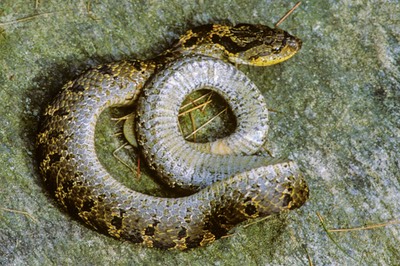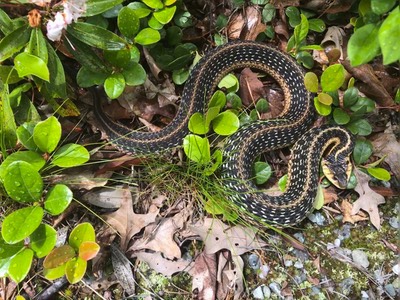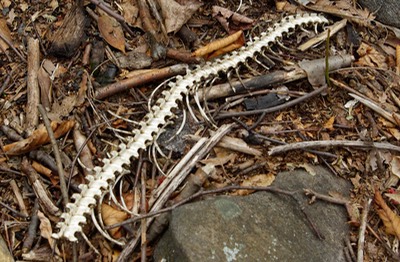
PREDATION AND DEFENSE
As you might imagine, snakes are relatively easy prey. After all, they can’t kick or scratch; they don’t really move all that quickly and once a predator grabs them they’re easy to get down, like a piece of linguine!

B
But for all who have nearly stepped on a snake, or tried to watch one under natural conditions, it’s impressive just how difficult they are to see. Of course, their color and patterns have clearly evolved to be cryptic. Even brightly colored snakes and very dark ones are tough to pick out amongst the dappled sunlight of the forest floor.
Certainly, though, most snakes don’t spend enormous amounts of time sitting out fully exposed (though basking gravid females seem to get away with it). Most snakes do move on the surface, of course, and this takes them away from a (presumably) known shelter.
When pressed, snakes exhibit a wide-range of behaviors to enhance their survival—from fleeing to active defense. Rattlesnakes’ remarkable rattles may have evolved to minimize predation, though this is far from being studied entirely. Hog-nosed snakes perform a most spectacular defense (read more here).
The following is my take on stages of attack and a snake’s defensive responses. Not all species exhibit all of these actions at all times, of course.
FIRST ENCOUNTER PHASE: Predator may or may not detect snake. Snake response: no movement or immediate retreat (partial retreat — e.g. head is retracted beneath cover, or entire snake makes exit).
1ST DEFENSE PHASE: Predator advances, looms large. Snake response: Retreat halted; partial coil; fight or flee posture; lift head; tail vibration (whether a rattlesnake or not); hissing; air intake to increase size, head flattens.
2ND DEFENSE PHASE: Predator attacks. Snake response: Full coil, striking (mock or actual biting); musk; void bowels and/or stomach contents; strong writhing.
Wouldn’t it be nice if we just developed Snake Watching as a Natural History pastime. It doesn’t (necessarily) have to be as intense or cutthroat as (some) birding. And, there’s a big advantage over chasing birds — snakes don’t usually come out until a normal part of the day! Another advantage: no need to learn (and forget every year) all those calls, songs, and other sounds birds make!
However it would be better if amateur herpetologists followed the birders’ example: look and watch, collect and report observations, but leave the snakes alone.
NOT ALL THAT RATTLES IS A RATTLESNAKE:
There are many people who encounter a snake that appear to be a rattlesnake because their tails are vibrating. This is not an uncommon occurrence - for both the snakes and observers.
Several of our local snakes will shake their tails but none produce a sound. However, if the tail is in dried leaf litter, near sturdy plants, or even against stones, a rattle-like sound is audible. Perhaps this is a case of auditory mimicry, though it is a common behavior of snakes and other animals around the world. Here, in Western Mass, milksnakes, black racers, black ratsnakes, northern Copperheads, Hognose, and even greensnakes rattle their tails when disturbed. So do White-footed and Deer mice. Tails make great sounds — think beaver and Wilson’s snipe.




